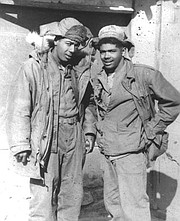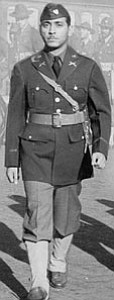The Veterans of the 231st Transportation Truck Battalion will celebrate their 67th Anniversary of being ordered to active duty by the Maryland National Guard on August 18, 1950 to support the Korean War, by attending church service at the Open Bible House of Prayers Baptist Church located at 3814 Gwynn Oak Avenue in Baltimore on Sunday, August 20, 2017. The Pastor is Rev. Seawall Smith.
Many citizens of the Baltimore Region may not be aware of the significance behind this veterans organization’s determination for many years to share the contributions with the wider communities by African Americans who answered the country’s call to war when needed.
Courtesy Photo
Louis S. Diggs, (right) a member of the 726th truck company with his brother George A. Diggs, a member of the 24th Infantry Regiment. They spent Christmas of 1951 together in Korea.
The all African American 231st Transportation Truck Battalion with it’s three Transportation Truck Companies, began as a semi-military African American organization in the early 1880s called the “Monumental City Guards,” who militarily competed with like semi-military units. Upon inspection by the Maryland National Guard in 1883, all of the units were accepted into the Maryland National Guards as “Separate Companies.” Only the Monumental City Guards continued for many years with the Guard and eventually became the “First Separate Company.”
The First Separate Company was activated during the Spanish American War, World War I where they fought in France with the French Army; World War II where they ended up in the Pacific. In 1947, the unit was converted to the 231st Transportation Truck Battalion, with the 147th 165th and 726th Transportation Truck Companies. The entire Battalion consisted of only African Americans, commanded by an African American Lieutenant Colonel.
Courtesy Photos
WWII image of LTC Vernon F. Greene, Commander of the 231st Transportation Truck Battalion took units from the 231st to Korea on August 19, 1950.
While the battalion was participating in their summer encampment in Virginia, in 1950 the entire battalion was ordered to active duty to support the Korean War. On August 19, 1950 the battalion had a mass formation in front of the Richmond Market Armory on Howard Street in Baltimore, and marched to the train station located at the end of the North Avenue bridge and was sent to Camp Edwards in Massachusetts for training. The 165th Truck Company remained in Baltimore until they were brought up to full strength, then they were sent to an Army base in Virginia.
Before 1950 came to an end, the Battalion Headquarters and the 726th Truck Company were ordered to Korea. After an extremely lengthy train ride across the United States, the units arrived in Seattle, Washington, where they joined with many other transportation units and boarded the troop ship “Sergeant Sylvester Antolak” for the long ocean voyage to Korea.
The ship arrived in Pusan, Korea on December 31, 1950 where the 726th Truck Company was selected to be immediately off-loaded and rushed into duty to begin moving units north during the United Nations Offensive and United Nation Summer-Fall Offensive Campaigns.
The 726th made history by being the first United States National Guard unit to arrive in Korea to support the war. The 231st Truck Battalion off-loaded the next day and began doing their share in the war effort. The two units were separated during the war. The units were required to operate under segregated conditions during the War.
As the men from the 231st Truck Battalion and 726th Truck Company completed their tours in Korea and returned home, members had to fight segregation all over again because the Maryland National Guard refused to allow them to continue their contracts to serve because the colors of the 231st Truck Battalion had not returned. This led to strong petitions by the officers of the 231st who refused to return as a segregated battalion because they felt they fought and earned the right to integrate the Maryland National Guard, which occurred in 1955 when the colors of the 231st were returned to the state of Maryland.
From 1953 to 1955, the 231st was organized under segregated conditions in the Maryland National Guard under the command of Captain Jesse P. Peaker. Then, in 1955 the governor of Maryland integrated the Maryland National Guard, the 231st Truck Battalion which was again reorganized under the command of Lt. Colonel Vernon F. Greene, who commanded the battalion when it was ordered to Korea.
It remained as such until 1960 when the name of 231st Transportation Truck Battalion was eliminated and began a new career as the 229th Transportation Battalion.


